What Are Terpenes?
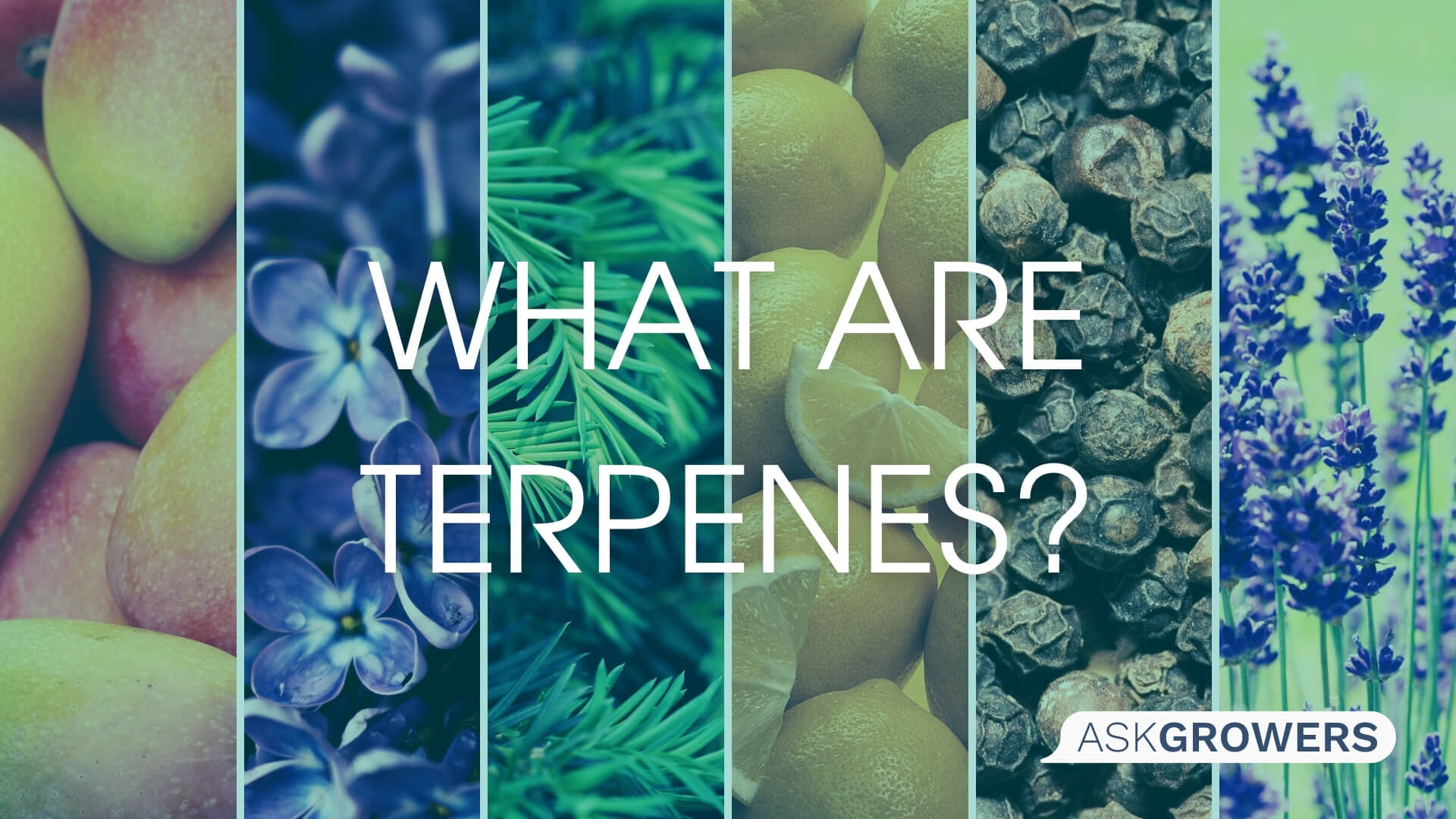
Terpenes are aromatic plant compounds referred to the category of secondary metabolites. Diverse plants release them in response to threats, such as animal grazing and infectious germs. Terpenes produce specific scents, which is typical among many plants, such as pine, cannabis, and lavender.
In this material, we will describe the most significant properties of terpenes. In particular, we will focus on the unique effects that such metabolites can produce while interacting with cannabinoids.
Just like many other plants, cannabis produces terpenes in response to any threat or physical harm. As you probably know, scientists pay much attention to the medical effects of
Read Also: Types of Weed Seeds You Need to Know About
cannabinoids, tetrahydrocannabinol, and cannabidiol. Meanwhile, scientists also start paying more and more attention to the unique properties of terpenes as cannabis compounds that have been underinvestigated for quite a long time.
What makes this aromatic oil so special? First of all, researchers are attracted by the question of the synergy between cannabinoids and terpenes and the effects they can produce together.
The scientific discourse on extracting terpenes from cannabis is densely connected to the research on the impact of tetrahydrocannabinol (THC) on human receptors. The point is that terpenes interact with the same receptors as tetrahydrocannabinol, which means that they may affect biochemical processes in the human brain. Terpenes can determine the amount of tetrahydrocannabinol that can cross the blood-brain barrier. What does it mean? Terpenes can affect the levels of feel-good chemicals in human blood, which allows them to directly impact the state of a person that consumes cannabinoids.
The observed phenomenon is known as the entourage effect. Have you ever thought about how specific sort of cannabis makes you feel energetic, while other sorts can make you more relaxed or uplifted? Well, the entourage effect, which channels the impact of cannabinoids, is the answer.
The ability to use the entourage effect for getting different cannabis impacts is what makes this phenomenon so attractive for growers.
Read Also: Types of Weed: Indica, Sativa, and Ruderalis – Differences Among Marijuana Types
Terpenes & Terpenoids – What Is the Difference?
Though these two words are often used as synonyms, they have a bit different meanings. Terpenes are hydrocarbons, and terpenoids are related to them. The only difference is that terpenoids are oxygen-containing. We must also note that not only regular people use these two words as interchangeable terms – one can notice that these words are used as terms with the same meaning even in the scientific literature.
Properties of Terpenes – How Can They Affect the Human Body?
How can terpenes affect our bodies? They can do it in lots of ways. There are about 25.000 of these compounds in various plants. However, terpenes can be divided into four main groups according to the number of carbon units they contain.
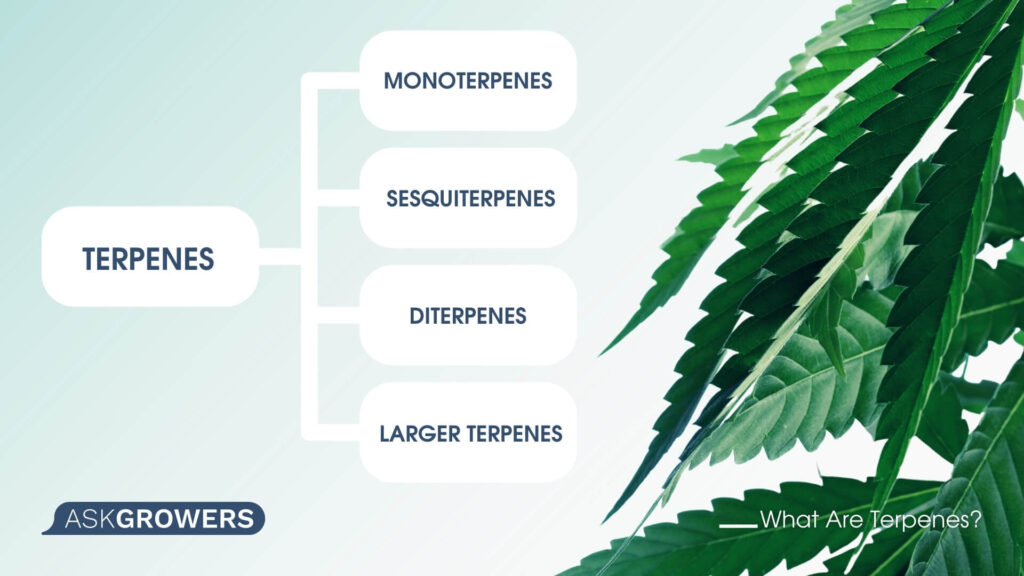
They are as follows:
- Monoterpenes (10 carbons)
- Sesquiterpene (15 carbons)
- Diterpenes (20 carbons)
- Larger terpenes (30 and more carbons)
Initially, the function of all these compounds was the same – as we have noted before, they all are aimed at protecting a plant, and yes, they are “responsible” for a plant’s flavor and taste. But when we speak about humanity, the number of ways to use these unique compounds is nearly endless. The analyzed compounds are widely used in healthcare. Studies show that various terpenes aid during respiratory inflammation, atopic dermatitis, arthritis, and neuroinflammation among various inflammatory diseases. They are also widely used in the beauty industry, perfumery, food industry, pharmaceutical industry, etc.
In fact, we know very little about the myriads of their possible properties. However, one of them definitely deserves the attention of experienced consumers – there is the synergy between cannabinoids and terpenes. Consequently, there is another factor to consider when choosing the strain, when growing the old strains and/or creating the new ones.
The Most Known Terpenes
In general, there are over one hundred compounds in the cannabis terpenes list. However, as we have already noted, people do not know much about them, at least at this stage of cannabis studies. Still, there are top-15 most common and most studied cannabis terpenes, which are as follows:
|
|
|
These are the most known terpenes, but the truth is there are top-10 terpenes you are likely to recognize even if you have never heard about them before. So let us take a look at the most common cannabis terpenes and their effects in more detail:
Myrcene
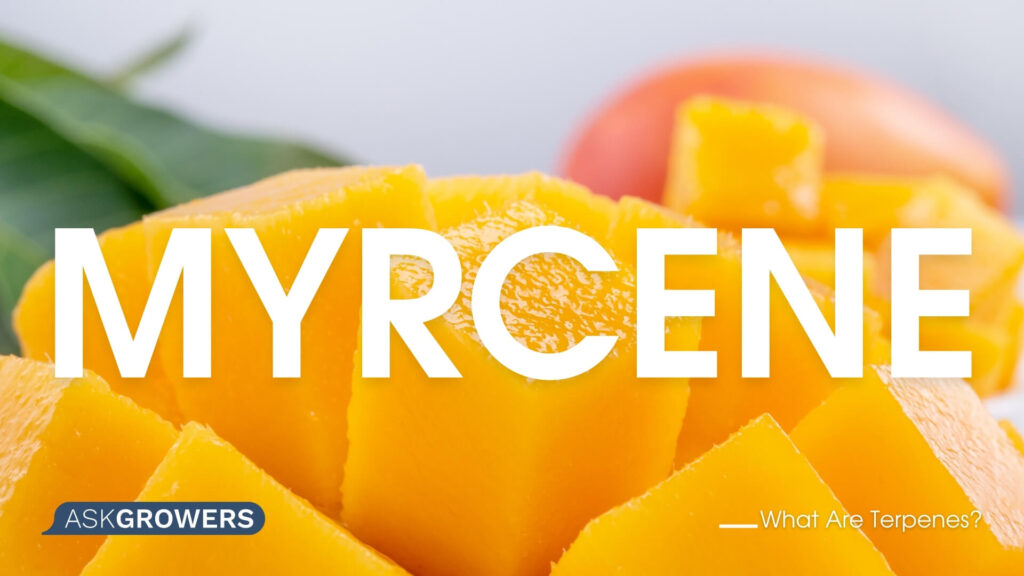
Basic characteristics of myrcene:
- Most common terpene
- Known for its calming, relaxing effects
- The spicy, herbal flavor
- Used for treating osteoarthritis, arthritis, and insomnia, relieving pain, reducing inflammatory processes
What is myrcene? It is a monoterpene that can be found not only in cannabis but also in, thyme, cardamom, hop and plenty of other plants, which, however, have at least one thing in common. Most plants containing this terpene have spicy, herbal flavor.
Generally speaking, it is the rock star in the world of terpenes. Everyone knows what it is and what it does. It is mostly famous for its sedating, calming, relaxing effects. As for the percentage, it is just huge compared to other terpenes. Like other terpenes, it can be used as a natural flavor intensifier. It is frequently used in the food industry and perfumery.
Recent researches have shown that myrcene produces sedative, anti-inflammatory, anesthetic effects. Furthermore, it also causes muscle relaxation. This terpene can also be useful for people suffering from sleep disorders: the results of experiments show that people who consume this terpene in cannabis go to sleep at the usual time, but it definitely lengthens sleep duration.
By the way, a lot of experienced consumers and newbies wonder if they can strengthen the effect of marijuana by eating mango. Firstly, we must note that myrcene goes directly to blood after a consumer inhales the smoke, while mango must be digested first. So, you can try to eat 1-2 mangos in 1-2 hours before you smoke a joint or use your vape pen and hope for some better effect.
In general, all consumers should keep in mind that this is the component that can change the effects of marijuana a bit, but it cannot turn it into something fundamentally different. Choose the strains with myrcene for the more relaxing experience but do not expect it to do anything extra special, and you will not be disappointed.
Limonene
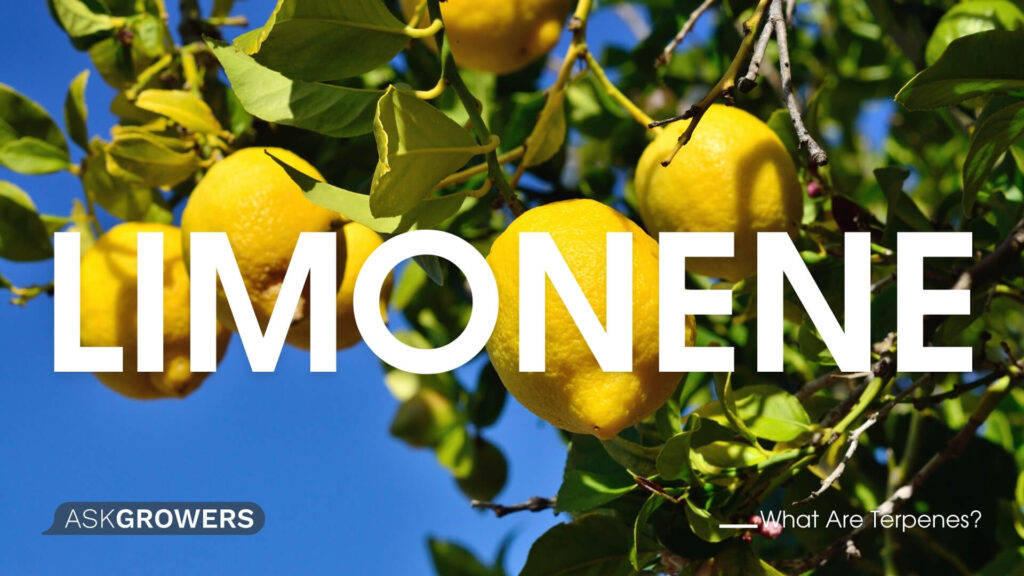
Basic characteristics of limonene:
- Second most common terpene
- Citrus aroma
- Found in citrus fruits, cannabis
- Known for its anti-stress and mood-enhancement effects
Used for treating stress, anxiety, relieving pain, treating skin problems, some types of cancer.
So, what is limonene? This is colorless, a liquid terpene found in citrus fruits and cannabis. It is frequently used in various industries, as well as for medical and non-medical purposes. Researches have shown that it is a great antioxidant that can treat anxiety, despondency, and stress and even helps patients suffering from certain types of cancers. It was also proven that the benefits of this terpene include pain relief, helping with heartburn, reducing inflammatory processes, and wound healing.
Of course, cannabis produces it, too. Moreover, it is the second most known terpene after the above-mentioned myrcene. So what effects do weed containing limonene produce? Well, they also make you feel better, but not in a relaxing way – cannabis containing much limonene is the high-energy marijuana that can definitely brighten your day.
There are plenty of strains with this terpene. It is this popular not only due to its great effects but also due to the great aroma. You can recognize the most popular limonene strains without any difficulty – their names usually include the word “lemon” like Lemon Skunk or Super Lemon Haze.
Read Also: What Are Cannabinoids, Their Types, and Effects?
Pinene
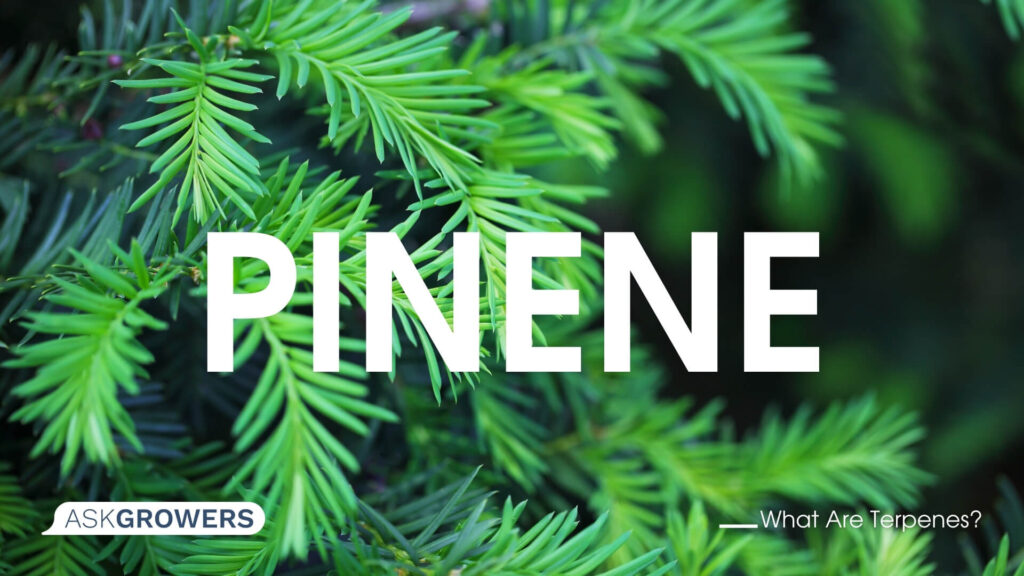
Basic characteristics of pinene:
- Most common in the natural world
- Pine aroma
- Found in pine needles, fennel, rosemary, basil, orange rind, parsley
- Known for its ability to neutralize some of the THC side effects
- Used for reducing inflammatory processes, treating asthmatic diseases and anxiety
As the name suggests, pinene is the terpene that smells a lot like pine and can be found in so many plants, including cannabis. Mother Nature, by the way, created this terpene and made it so strong and recognizable for a reason – this component protects plants against threats.
More importantly, pinene produces plenty of effects, which produce anti-inflammatory and antiasthmatic effects, pain relief, and anti-anxiety. It also helps open airways and can be used as the component neutralizing some of the tetrahydrocannabinol side effects, in particular, memory losses.
The percentage of pinene in cannabis depends on plenty of factors, including growth environment, flowering time, and drying.
Caryophyllene
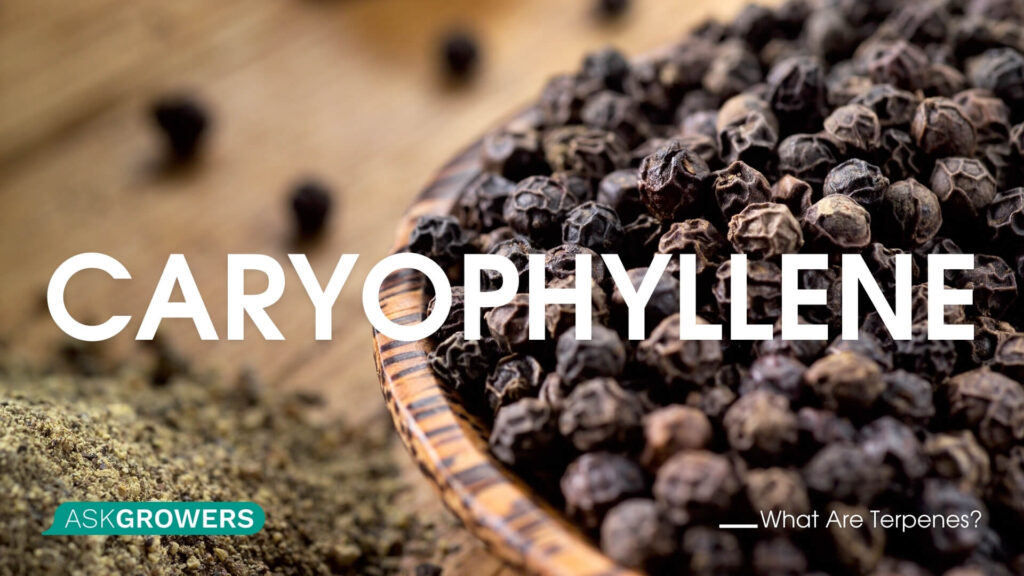
Basic characteristics of caryophyllene:
- Peppery, spicy
- Found in clover, hop, basil, oregano, cinnamon, black pepper, cannabis
- Known for its anti-stress and mood-enhancement effects
- Affects CB2 receptors without affecting CB1
- Helps to handle the stress and cope with anxiety
- Used to treat various diseases and disorders, from Crohn’s disease to cancer
It is produced by plenty of plants, including cinnamon, basil, black pepper, but the highest level of this compound is found in cannabis. Cannabis oil extracted from heads can contain up to 38% of caryophyllene.
We must also emphasize that this is the only terpene that affects receptors in the endocannabinoid system, i.e. act like other compounds of cannabis plants known as cannabinoids. However, it interacts only with CB2, and that is why this terpene cannot get you high.
Most researchers believe that it has more healing properties than we use now. Generally speaking, it can be used as an anesthetic, anti-inflammatory, it helps to treat mood disorders, stress, despondency, and nervousness and even to treat alcohol addiction. It can also help to treat cancer, Crohn’s disease, and ulcerative colitis.
Terpinolene
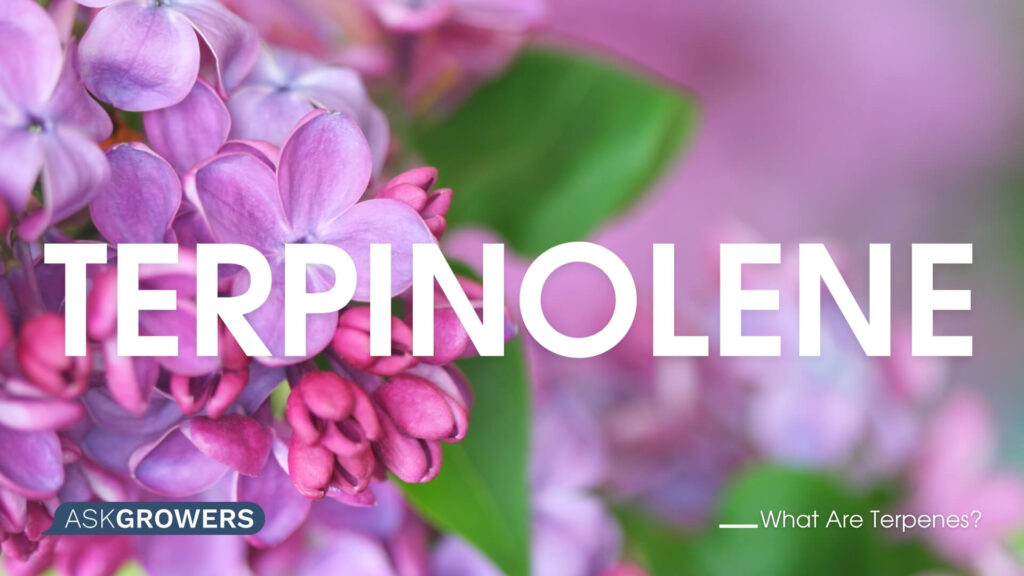
- Fruity aroma
- Considered having an uplifting effect
- Found in lilacs, cumin, tea tree
- Used to treat fungal, cancer, infections
Terpinolene is known for its fruity aroma with some woodsy, citrus, and floral notes. It is considered that it produces an uplifting effect. It is also of the compounds that can be successfully used to cope with nervousness and stress. Like many other terpenes, terpinolene is investigated for its possible anti-cancer effects and is used to treat fungal. It is also used as an antibacterial and sedative.
Linalool
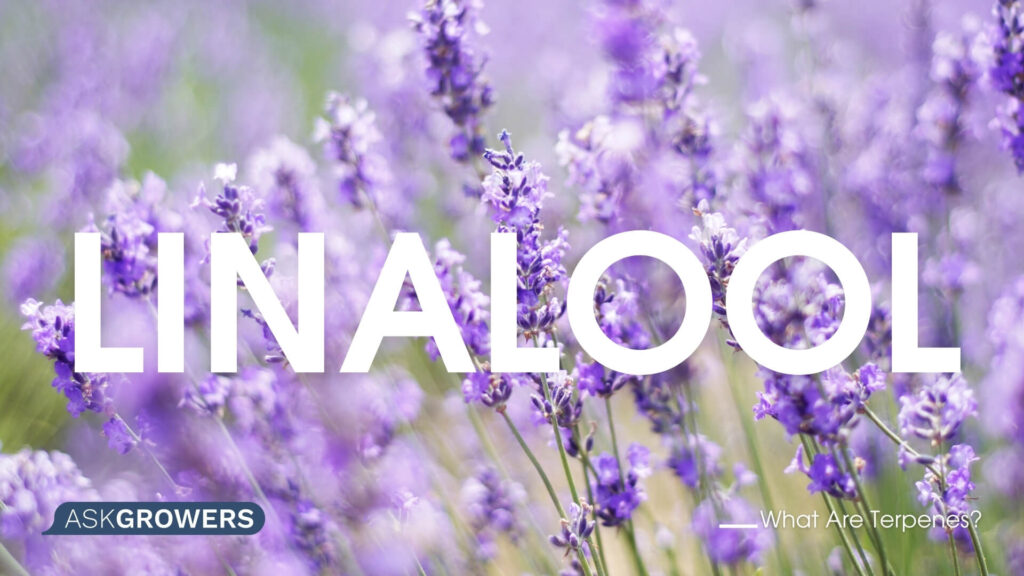
The main features of linalool are the following:
- Has a lavender scent
- It can be commonly found in lavender, coriander, or birch trees
- Has a calming effect
- Has a very low risk of any adverse effects
What makes linalool so notable is its outstanding scent. It does not stick in the human body for long, which makes it safe for your health. This compound is also often used by people who want to cope with sleep issues.
Geraniol

Basic characteristics of geraniol:
- It can be found in many products, such as rose oil, lemongrass, and oranges
- Has a recognizable scent that combines the aromas of fruits, rose, and citrus
- Has a significant anti-inflammatory potential
This compound takes a valuable place in the terpenes chart. It adds sweetness to the scent of the most popular cannabinoids. It is also widely used in medicine for pain reduction.
Borneol
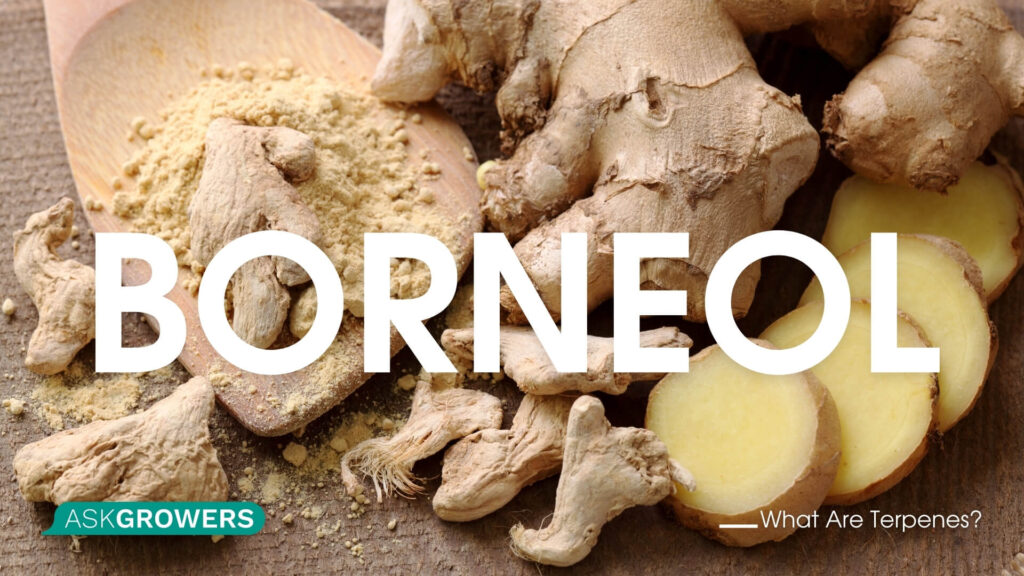
- An important element in the Chinese traditional medicine
- Borneol can be found in ginger, camphor, marjoram, and many other plants
- Has a woody aroma
Borneol is notable for its multiple medical features. In particular, it strengthens the immune system and has an anti-inflammatory effect. In cannabis, borneol produces a notable relaxing yet not sedative effect.
Humulene
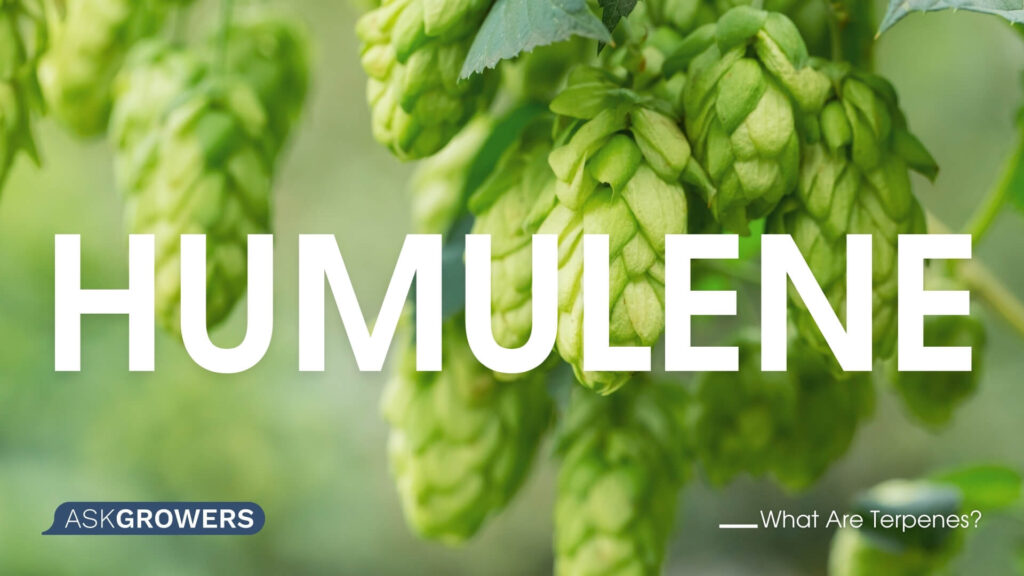
- Has a unique spicy aroma
- Is widely used for the termination of tumors and cancer cells
- Has strong antibacterial properties
Humulene is frequently present in cannabis in moderate quantities. It gives cannabis a notable aroma and protects the plants from bacteria and fungi at the stage of growing.
Eucalyptol
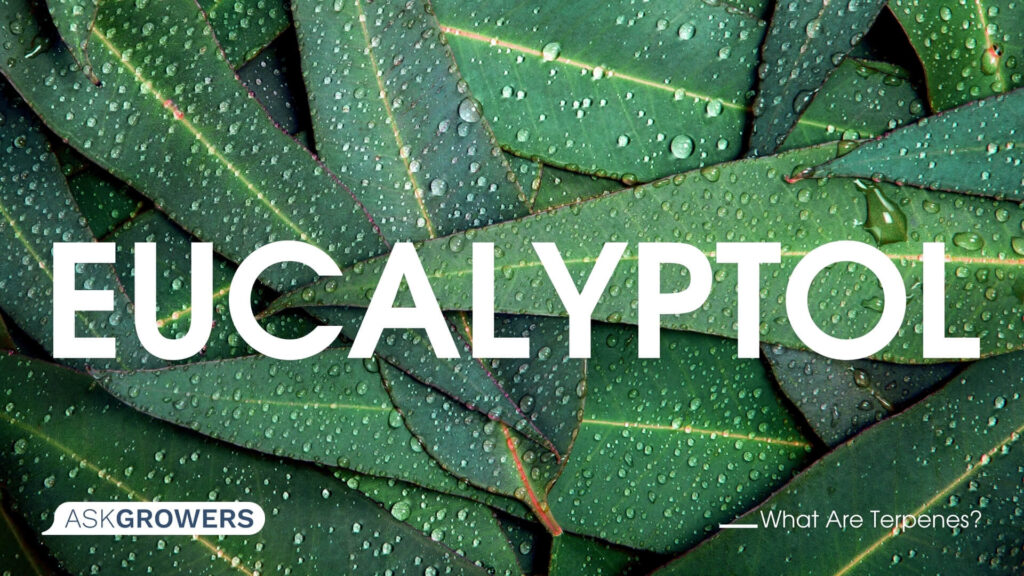
- Has a fragrant fresh aroma
- Aids in relieving sinus and nasal congestion
- Known for its ability to provide relief from pain
Eucalyptol is present in many cannabis strains. It is especially popular when it comes to medical cannabis. Primarily, the point is in its pain treatment properties.
Effect of terpenes on cannabis products
Terpenes directly impact a broad range of cannabis products. In the case of edibles, the effect is the following:
- Terpenes add characteristic aroma to multiple strains
- They enhance the effect of strains
- They ensure the entourage effect
- They may have temporary anxiolytic effects
When it comes to concentrates, the effect is quite similar:
- They provide strains with a more attractive scent
- They make strains taste better
- They ensure the entourage effect
Top Recommended Seeds for Growing
Conclusion
Terpenes are unique compounds. You cannot even be sure that every batch of the same strain contains the same amounts of certain terpenes. A lot of factors influence the concentration, and only the results of the lab analysis can show how much limonene or terpinolene cannabis contains.
Nevertheless, despite they are not studied yet, though the difference between some of them is very small, familiarity with their properties allows growers, consumers, and even scientists to understand how cannabis can work.
The most important thing is that they have a huge medical value due to their anti-inflammatory properties. Cannabis extracted terpenes attract the attention of growers with their ability to influence the way our bodies interact with more “famous” compounds – cannabinoids. In connection with cannabinoids, terpenes can create a unique synergy, known as the entourage effect. The number of combinations and possible effects can be mind-blowing. Fortunately, the best scientists express interest in this field – a lot of labs are already working on identifying more properties of terpenes. Maybe, one day we will be able to consider the terpene profiles to make the most of this unique plant.
References
https://www.medicalnewstoday.com/articles/what-are-terpenes
https://www.ncbi.nlm.nih.gov/pmc/articles/PMC3165946/

 Health
Health
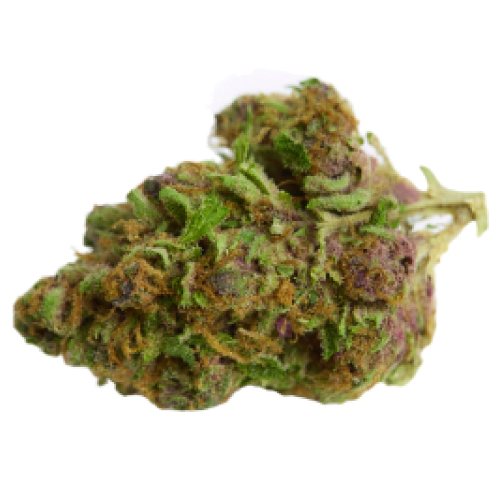
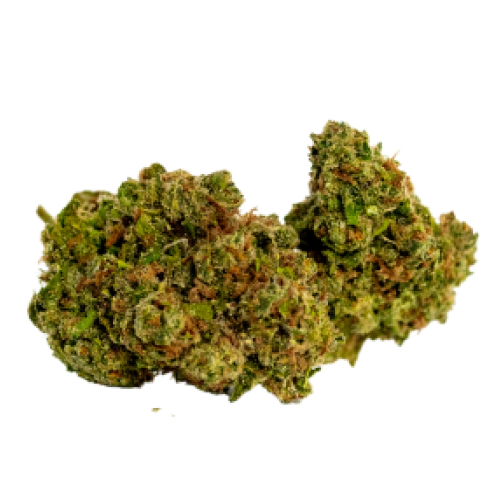
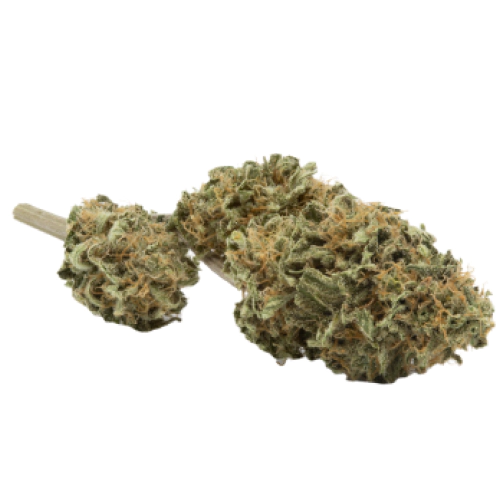

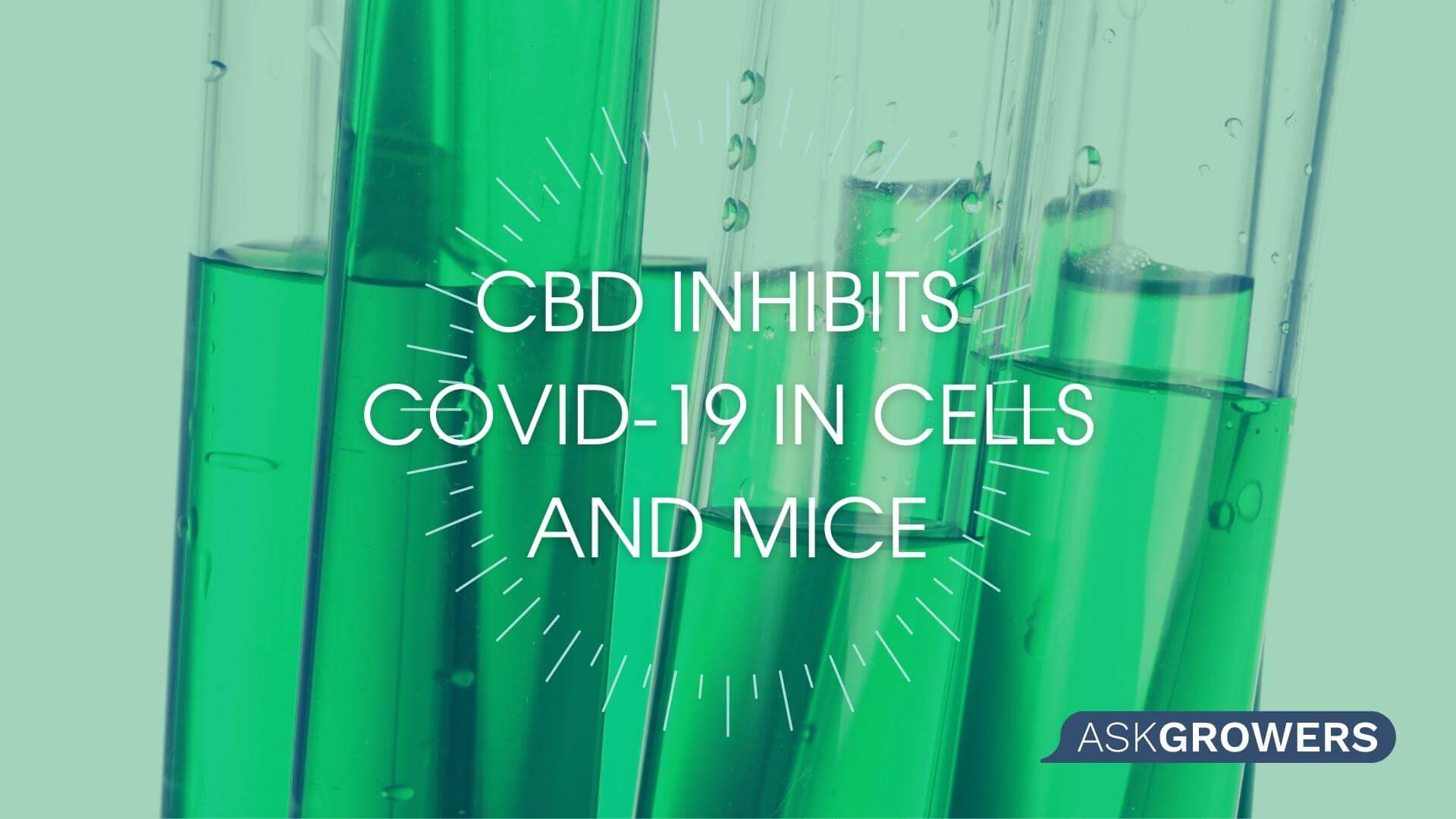





 (1).png)
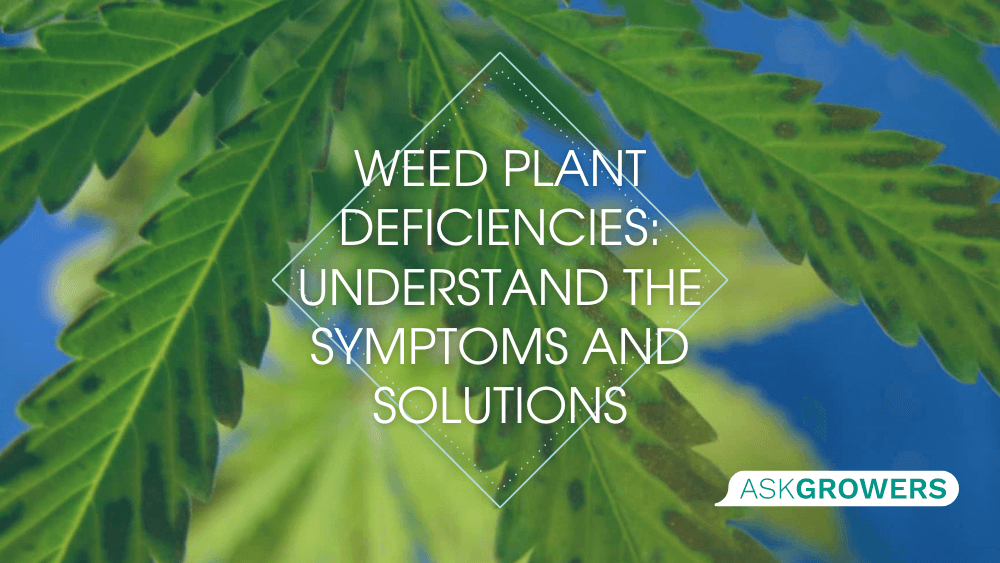
.jpg)





Be the first and share your opinion
Write a Review